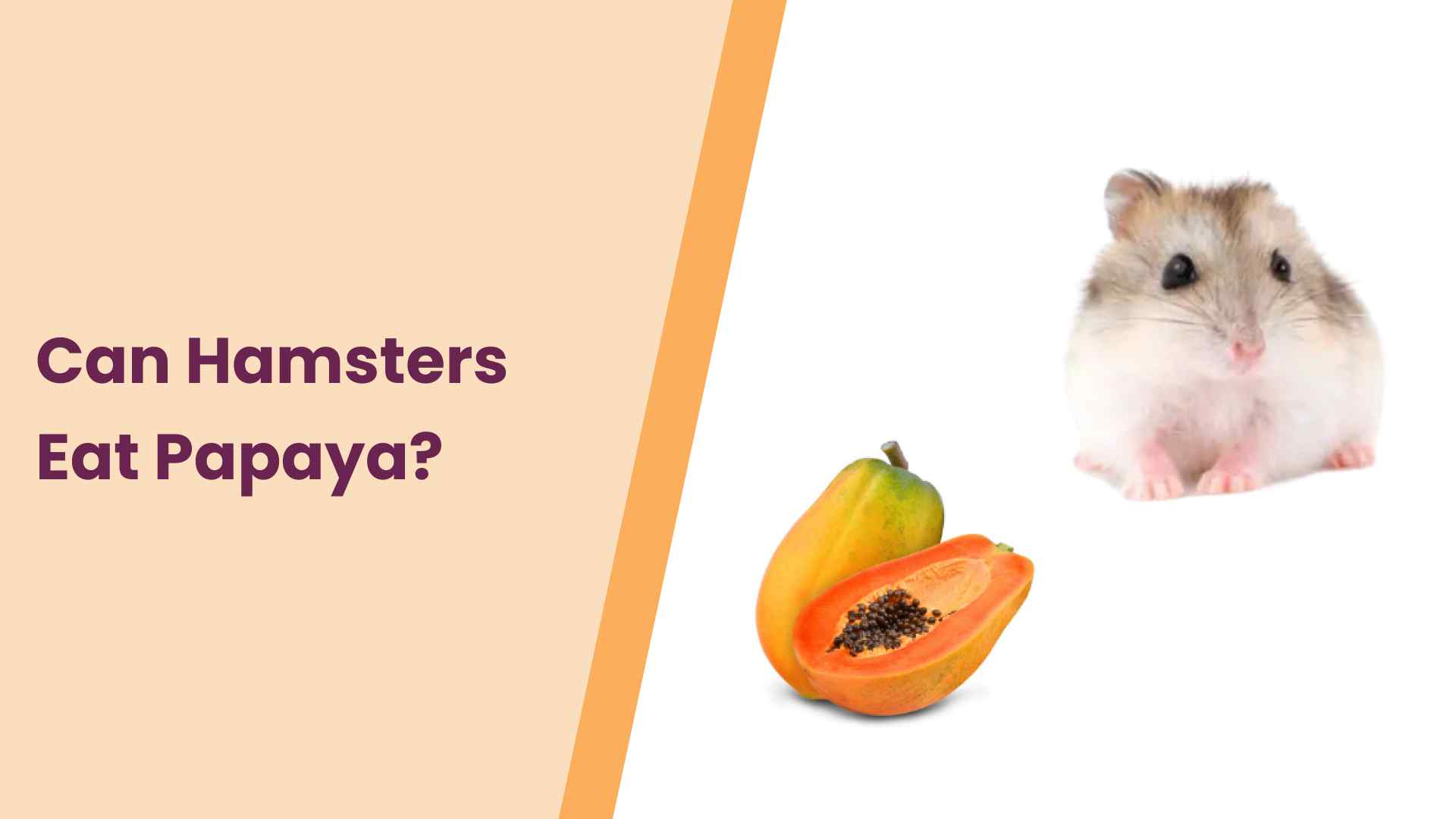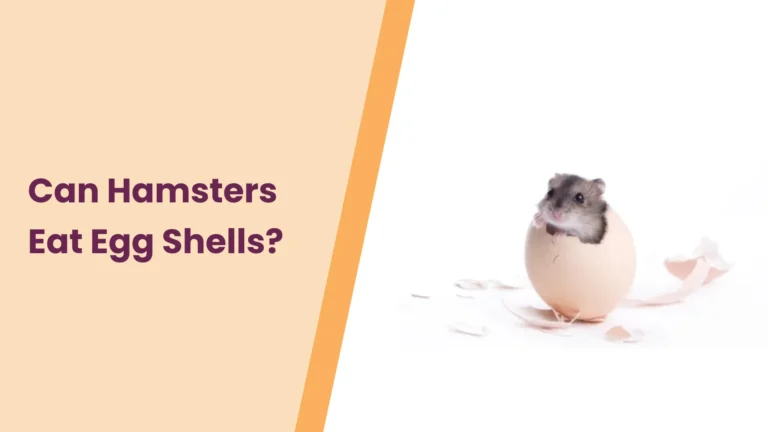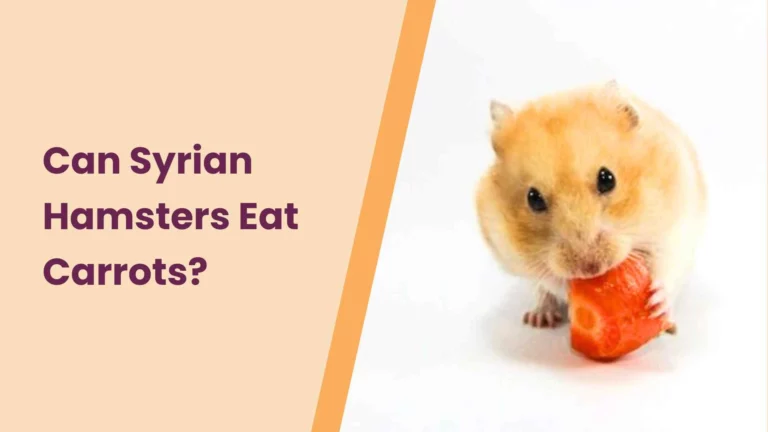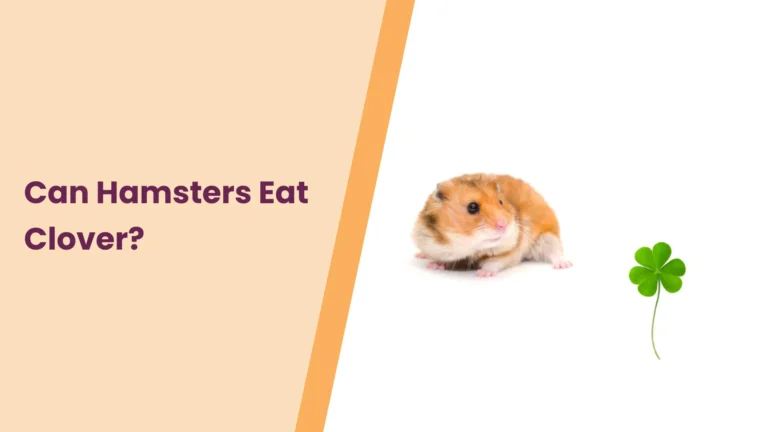Can Hamsters Eat Papaya? – All You Need To Know
Imagine the delightful sight of your tiny, furry friend scurrying around their cage, their inquisitive whiskers twitching with excitement. As devoted hamster parents, we’re always on a quest to ensure our beloved pets lead a happy and healthy life. That’s why understanding what goes into their diet is of paramount importance.
In this guide, we dive headfirst into the intriguing world of hamster nutrition to answer a common question that might have crossed your mind: Can hamsters eat papaya? We’re about to peel back the layers of this tropical fruit and discover if it can be a scrumptious addition to your hamster’s menu.
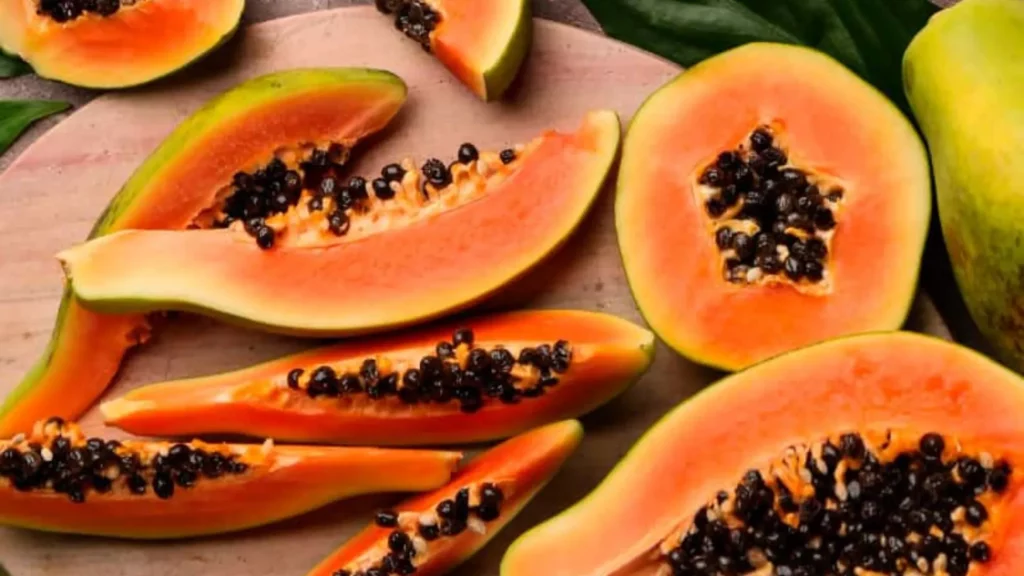
Let’s embark on this delectable journey to uncover the secrets of papaya and whether it can tickle your hamster’s taste buds or become a sweet indulgence to cherish with caution.
Hamster Diet Basics
When it comes to keeping your little ball of fur healthy and happy, understanding the basics of your hamster’s diet is the first step on the path to responsible pet ownership. Just like us, our tiny companions have their own dietary preferences and requirements.
Pellets – The Foundation:
The foundation of your hamster’s diet often consists of high-quality hamster pellets. These specially formulated nuggets are designed to provide essential nutrients and vitamins to support your hamster’s overall well-being. When choosing pellets, opt for those with minimal additives and fillers. These nuggets ensure that your furry friend gets a balanced diet and all the necessary nutrients for optimal health.
Fresh Foods – A Burst of Flavor:
While pellets are the staple, fresh foods should also be part of your hamster’s diet. Offer a variety of fresh vegetables and fruits in small, manageable portions. These fresh additions not only provide essential vitamins and minerals but also offer variety in taste and texture. Fresh foods introduce excitement into your hamster’s mealtime, just like how we enjoy a refreshing salad or a crisp apple.
Treats – A Dash of Indulgence:
Treats are the delightful surprises in your hamster’s diet. They’re the equivalent of that occasional sweet treat or a special meal for us. While your hamster undoubtedly loves the extra indulgence, it’s crucial to offer treats in moderation. Overdoing it can lead to dietary imbalances and potential health issues. Choose hamster-specific treats from a trusted source to ensure they are safe and nutritionally appropriate for your pet.
The Significance of Balance:
The key to keeping your hamster in the pink of health lies in maintaining a well-balanced diet. Think of it as a symphony of flavors and nutrients, with each element playing its part in harmony. Just as too much sugar and junk food isn’t good for us, an imbalanced diet can negatively impact your hamster. The right balance of pellets, fresh foods, and treats ensures that your furry friend receives all the vital nutrients required for growth, energy, and overall happiness.
Nutritional Value of Papaya
Papaya, with its vibrant orange hue and tropical allure, is not only a treat for the human palate but also offers a surprising array of health benefits, even for our pint-sized hamster friends.
Rich in Vitamins and Minerals:
Papaya is a treasure trove of essential vitamins and minerals. It’s loaded with vitamin C, a powerful antioxidant that boosts the immune system and keeps your hamster’s fur coat looking lustrous. Additionally, papaya provides a good dose of vitamin A, which supports eye health and overall growth. These vitamins play a vital role in ensuring your hamster remains active and radiant, just as we feel when we consume our daily vitamins.
Dietary Fiber for Digestive Health:
In the world of nutrition, fiber is the unsung hero that ensures smooth digestion. Papaya is brimming with dietary fiber, which helps keep your hamster’s digestive system in tip-top shape. Think of it as the digestive equivalent of a gym workout – it keeps things moving and prevents constipation. Just as we prioritize our digestive health, your hamster can benefit from papaya’s natural fiber content.
Antioxidants for Well-Being:
Papaya is packed with antioxidants like beta-carotene, which help neutralize harmful free radicals in your hamster’s body. This antioxidant protection is akin to the umbrella we use to shield ourselves from the elements. It keeps your hamster’s cells safe from damage, promoting longevity and overall well-being.
Hydration and Nutrient Absorption:
The high water content in papaya can help keep your hamster hydrated, especially during warm weather. Proper hydration is vital for nutrient absorption, just as we need to stay hydrated to feel our best.
Benefits of Including Papaya in Your Hamster’s Diet:
Incorporating papaya into your hamster’s diet can be a smart and health-conscious choice. Its rich nutrient profile can enhance your hamster’s overall vitality and happiness. However, as with any treat, moderation is key. Think of papaya as a special delicacy – an occasional treat to brighten up your hamster’s day.
Can Hamsters Eat Papaya?
Now that we’ve uncovered the nutritional treasures hiding within papaya, let’s address the burning question: Can hamsters eat papaya? The answer is a resounding “Yes,” but there are some important considerations to keep in mind.
Yes, Hamsters Can Enjoy Papaya:
Papaya is indeed a hamster-friendly fruit. The vitamins, minerals, and fiber it offers can be a delightful addition to your hamster’s diet. Like us savoring a delicious fruit salad, your hamster can relish the natural sweetness and health benefits of papaya.
Benefits of Papaya for Hamsters:
When you offer your hamster a small piece of papaya, you’re providing them with a tasty dose of essential nutrients. The vitamin C in papaya can boost your hamster’s immune system, helping them ward off illnesses just as we rely on vitamin C to stay healthy. The dietary fiber in papaya supports smooth digestion, ensuring your hamster’s tummy remains happy and active.
Moderation Is Key:
While papaya is a wonderful treat, it’s vital to emphasize moderation. Imagine savoring a small piece of your favorite dessert; too much can lead to unwanted consequences. The same principle applies to your hamster’s papaya consumption. Offering a small, bite-sized portion a couple of times a week is sufficient to enjoy the benefits without overindulging.
Freshness Matters:
Just as we prefer fresh, juicy fruits, your hamster also deserves the best. When sharing papaya with your pet, ensure it’s fresh and free from any signs of spoilage. Fresh papaya guarantees that your hamster receives the full spectrum of nutrients and the delightful taste they deserve.
Remove Seeds:
Before presenting papaya to your hamster, take a moment to remove the seeds. The seeds may not be toxic, but they can be a choking hazard or lead to digestive discomfort. Think of it as preparing a safe and delectable meal for your furry companion.
In the upcoming sections, we’ll delve further into the ins and outs of offering papaya to your hamster, including how to prepare it, potential risks to watch out for, and the signs that your hamster might be overindulging. We’re here to guide you on the delightful journey of including papaya in your hamster’s diet while ensuring their health and happiness.
Health Benefits of Papaya for Hamsters
You might be wondering, “What’s in it for my hamster when I offer them papaya?” Well, the answer is a host of potential health benefits that can brighten up their day and keep them at their furry best.
Boosting the Immune System:
Papaya is a treasure trove of vitamin C, an immune-boosting superhero. Just like we reach for vitamin C to stay healthy, your hamster can benefit from this vital nutrient. A strong immune system helps your pet ward off illnesses, ensuring they lead a happy and active life.
Aids Digestion:
Papaya contains dietary fiber, which is fantastic for digestion. A well-functioning digestive system is vital for your hamster’s comfort and overall well-being. It ensures they process their food efficiently and minimizes tummy troubles.
Promotes Healthy Skin and Fur:
The vitamin A found in papaya is essential for maintaining healthy skin and a glossy fur coat. Just like we invest in skincare to keep our complexion radiant, vitamin A does the same for your hamster’s skin and fur.
Hydration and Nutrient Absorption:
Papaya’s high water content can help keep your hamster hydrated. Proper hydration is vital for nutrient absorption, ensuring your furry friend gets the most out of their diet.
Antioxidant Protection:
The antioxidants in papaya, such as beta-carotene, help protect your hamster’s cells from damage caused by free radicals. This is akin to the armor we wear to shield ourselves from life’s challenges, ensuring a longer, happier life.
Serving Papaya in Small Portions:
As with any treat, the key to reaping these benefits without overindulging is moderation. Offer your hamster small, appropriately-sized pieces of papaya. These bite-sized delights can be the highlight of their day, just as a small treat can brighten our mood.
Risks and Considerations
While papaya offers a host of health benefits, it’s essential to be aware of potential risks and exercise prudence when introducing it into your hamster’s diet.
Excess Sugar Content:
Papaya, like many fruits, contains natural sugars, which can be a double-edged sword. While these sugars make the fruit sweet and delicious, too much sugar can lead to health issues. Imagine indulging in your favorite dessert—overindulgence can lead to sugar-related concerns.
For your hamster, excess sugar intake may result in weight gain, dental problems, or even diabetes. To prevent these issues, it’s vital to offer papaya in small, measured portions. Just as we keep an eye on our sugar intake, being mindful of your hamster’s is equally important.
Digestive Sensitivity:
Every hamster is unique, and some may have more sensitive digestive systems than others. While papaya’s fiber content can promote healthy digestion, it can occasionally cause stomach upset if offered in excess.
Just as certain foods don’t agree with us, some hamsters may be more sensitive to papaya. It’s important to monitor your pet’s reaction and adjust their papaya intake accordingly.
Allergies and Individual Reactions:
Just as some people have food allergies or sensitivities, hamsters can also have individual reactions to specific foods. While papaya is generally well-tolerated, it’s possible that some hamsters may not respond well to it.
Keep an eye out for any adverse reactions such as diarrhea, changes in behavior, or signs of discomfort. In such cases, it’s best to consult with a veterinarian.
The Importance of Moderation:
The golden rule when offering papaya to your hamster is moderation. Think of it as providing a delightful treat—a small piece of papaya can be the highlight of your hamster’s day, just as a special treat brightens ours.
By controlling the amount and frequency of papaya treats, you can enjoy the benefits without putting your pet’s health at risk.
Monitoring and Responsiveness:
As responsible hamster owners, it’s crucial to be vigilant. Keep an eye on your pet’s behavior and overall health when introducing new foods like papaya. If you notice any unusual or concerning changes, such as changes in stool or activity levels, consult with a veterinarian. Just as we seek medical advice when facing health concerns, your hamster’s well-being is equally important.
Preparing Papaya for Your Hamster
As you prepare to introduce papaya to your hamster’s diet, it’s essential to ensure that the process is as smooth and safe as possible. Here are some guidelines to consider:
Selecting Fresh Papaya:
Just as we prefer our fruits to be fresh and flavorful, your hamster deserves the same. When choosing papaya for your pet, look for ripe and fresh fruit. Avoid papayas that appear overripe, mushy, or show signs of spoilage, as these may not be suitable for your furry friend. Opt for papayas that are firm to the touch and have a pleasant, sweet aroma.
Washing and Cleaning:
Before serving papaya to your hamster, be sure to wash and clean it thoroughly. Like us, your pet deserves a clean and safe meal. Remove any dirt or residue from the papaya’s skin. This simple step ensures that your hamster enjoys a hygienic treat.
Removing Seeds:
Papaya seeds, while not toxic, can pose a choking hazard or lead to digestive discomfort. As you prepare the papaya, take a moment to remove the seeds. Think of it as ensuring your hamster’s safety while preparing their delicious snack.
Cutting into Small, Manageable Pieces:
Papaya should be served in small, appropriately-sized pieces. Just as we cut our food into manageable portions, your hamster will appreciate bite-sized bits of papaya. These small pieces make it easier for your pet to eat, reducing the risk of choking or overeating.
Portion Control:
Portion control is vital to ensure that your hamster receives the right amount of papaya. Consider offering a piece of papaya that is no larger than the tip of your finger, a size that’s safe and manageable for your furry friend. Remember, moderation is key when it comes to treats.
By following these guidelines, you can ensure that your hamster’s papaya experience is not only enjoyable but also safe and hygienic. In the upcoming sections, we’ll explore more practical tips on serving papaya to your hamster, as well as potential risks and signs to watch out for. With a little care and consideration, you can make papaya a delightful and healthful addition to your pet’s diet.
Signs of Overfeeding
While offering your hamster a delicious treat like papaya can bring joy, it’s crucial to keep a watchful eye for signs of overindulgence. Here are some common signs to look out for and what to do if you observe them:
Changes in Stool:
One of the first indicators of overfeeding is a change in your hamster’s stool. If you notice loose, watery, or unusually colored droppings, it may be a sign that your hamster has had a bit too much papaya. Just as we recognize changes in our digestive patterns, it’s essential to monitor your pet’s as well.
Weight Gain:
Regular weighing of your hamster is a good practice. If you notice a significant increase in your hamster’s weight, it could be due to overindulgence in high-sugar foods like papaya. Similar to how we manage our weight, maintaining your hamster’s ideal body condition is vital for their health and well-being.
Lethargy and Reduced Activity:
If your hamster becomes lethargic, less active, or displays a lack of interest in their usual activities, it could be a sign of overfeeding. Just as we feel sluggish after consuming too much, your hamster may show a decrease in energy when they’ve had an excess of papaya.
Behavioral Changes:
Changes in your hamster’s behavior can be an indicator of overindulgence. If your pet appears more anxious, irritable, or exhibits unusual behaviors, it’s time to investigate. Be attuned to their habits, as any abrupt shifts may be a red flag.
Consult a Veterinarian:
If you observe these signs of overfeeding or have any concerns about your hamster’s health, don’t hesitate to consult a veterinarian. Just as we seek medical advice when feeling unwell, your hamster deserves the same care. A vet can provide guidance and recommend necessary actions to address any health issues promptly.
Remember, the key to a happy and healthy hamster is moderation. While papaya can be a delightful treat, offering it in small, appropriately-sized portions ensures that your pet enjoys the benefits without overindulging. Monitoring your hamster’s behavior and well-being allows you to take action promptly if you observe any signs of overfeeding.
Other Hamster-Friendly Fruits
While papaya can be a delightful addition to your hamster’s diet when offered in moderation, there are plenty of other fruits your furry friend can savor as occasional treats. Here’s a list of hamster-friendly fruits to diversify their culinary experience:
Hamster-Friendly Fruits:
Apple: A slice of fresh apple can be a crisp and tasty treat for your hamster.
Pear: Similar to apples, pears offer a delightful crunch and natural sweetness.
Banana: Offer a small, ripe piece of banana for a creamy and flavorful indulgence.
Strawberry: A juicy strawberry can be a refreshing and vitamin-packed treat.
Blueberry: Blueberries can provide antioxidants and a burst of flavor.
Fruits to Avoid:
Citrus Fruits: Citrus fruits like oranges, lemons, and grapefruits are too acidic for hamsters and can upset their stomach.
Grapes: Grapes have a high sugar content and can pose choking hazards due to their size.
Cherries: Cherry pits can be toxic, and the fruit can be too sugary for hamsters.
Avocado: Avocado contains a substance called persin, which can be toxic to small animals.
Peaches: The pits of peaches contain a compound that can be harmful to hamsters.
Remember that even with these hamster-friendly fruits, moderation is key. Offer them as an occasional treat, ensuring the portions are small and manageable for your furry companion. Just as we enjoy the occasional dessert, your hamster can appreciate these delightful fruit treats to brighten up their day.
Conclusion
In our journey through the world of hamsters and papaya, we’ve uncovered a delightful treat that can add a burst of flavor and nutrition to your pet’s diet. The answer to the question, “Can hamsters eat papaya?” is a resounding yes, but with a few crucial caveats. Moderation is the key – offering small, appropriately-sized portions ensures that your furry friend enjoys the benefits without overindulging.
Papaya, rich in vitamin C, dietary fiber, and antioxidants, can boost your hamster’s immune system, promote healthy digestion, and enhance their skin and fur. It’s a treat that can bring joy and well-being.
While papaya is a fantastic addition to your hamster’s menu, remember to be mindful of the potential risks, including excess sugar content and digestive sensitivity. As responsible hamster owners, staying vigilant and attuned to your pet’s needs is paramount. And let’s not forget, there’s a whole world of hamster-friendly fruits to explore. From apples to strawberries, you can provide a variety of occasional treats to tantalize your pet’s taste buds.
By following these guidelines and practicing responsible treat-giving, you can ensure that your hamster lives a happy and healthy life, relishing each delicious bite of papaya and other delightful fruits. So, treat your tiny friend to a world of flavors, always in moderation, and watch them thrive and shine.
“Your thoughts and experiences matter, and we’d love to hear from you. Have you introduced papaya to your hamster’s diet? Do you have any tips or stories to share about your pet’s favorite treats? Feel free to leave your comments, questions, or insights below. Engage with our community and join the conversation.
If you found this guide helpful, don’t forget to share it with other hamster enthusiasts on your favorite social media platforms. Together, we can create a valuable resource for hamster owners looking to provide the best care for their furry companions. Thank you for being a part of our hamster-loving community!” – Hamsterpit.

